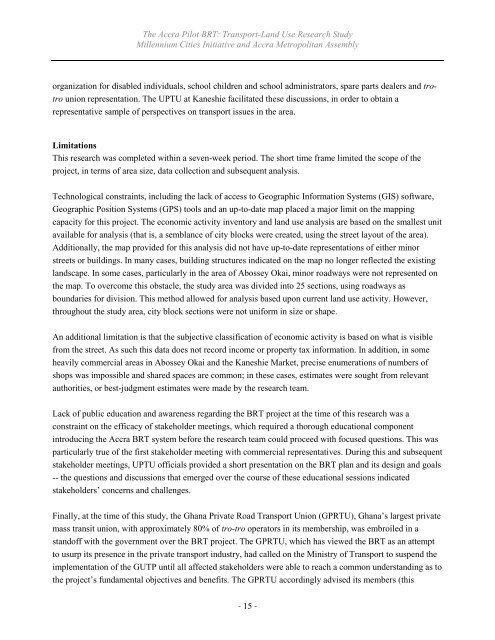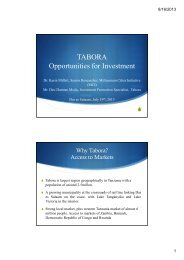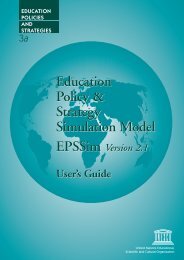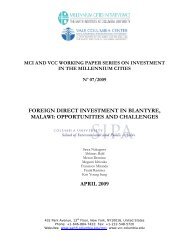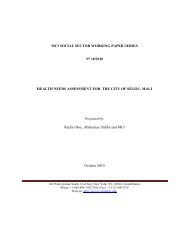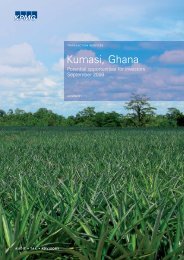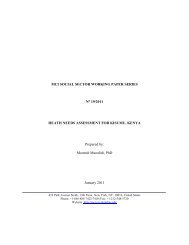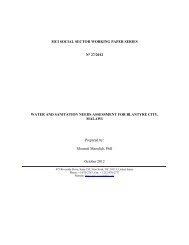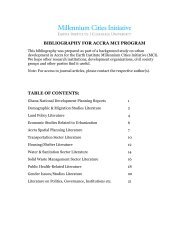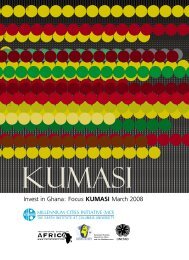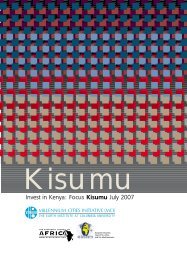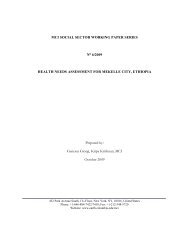Transport-Land Use Research Study - Millennium Cities Initiative ...
Transport-Land Use Research Study - Millennium Cities Initiative ...
Transport-Land Use Research Study - Millennium Cities Initiative ...
You also want an ePaper? Increase the reach of your titles
YUMPU automatically turns print PDFs into web optimized ePapers that Google loves.
The Accra Pilot BRT: <strong>Transport</strong>-<strong>Land</strong> <strong>Use</strong> <strong>Research</strong> <strong>Study</strong><br />
<strong>Millennium</strong> <strong>Cities</strong> <strong>Initiative</strong> and Accra Metropolitan Assembly<br />
organization for disabled individuals, school children and school administrators, spare parts dealers and trotro<br />
union representation. The UPTU at Kaneshie facilitated these discussions, in order to obtain a<br />
representative sample of perspectives on transport issues in the area.<br />
Limitations<br />
This research was completed within a seven-week period. The short time frame limited the scope of the<br />
project, in terms of area size, data collection and subsequent analysis.<br />
Technological constraints, including the lack of access to Geographic Information Systems (GIS) software,<br />
Geographic Position Systems (GPS) tools and an up-to-date map placed a major limit on the mapping<br />
capacity for this project. The economic activity inventory and land use analysis are based on the smallest unit<br />
available for analysis (that is, a semblance of city blocks were created, using the street layout of the area).<br />
Additionally, the map provided for this analysis did not have up-to-date representations of either minor<br />
streets or buildings. In many cases, building structures indicated on the map no longer reflected the existing<br />
landscape. In some cases, particularly in the area of Abossey Okai, minor roadways were not represented on<br />
the map. To overcome this obstacle, the study area was divided into 25 sections, using roadways as<br />
boundaries for division. This method allowed for analysis based upon current land use activity. However,<br />
throughout the study area, city block sections were not uniform in size or shape.<br />
An additional limitation is that the subjective classification of economic activity is based on what is visible<br />
from the street. As such this data does not record income or property tax information. In addition, in some<br />
heavily commercial areas in Abossey Okai and the Kaneshie Market, precise enumerations of numbers of<br />
shops was impossible and shared spaces are common; in these cases, estimates were sought from relevant<br />
authorities, or best-judgment estimates were made by the research team.<br />
Lack of public education and awareness regarding the BRT project at the time of this research was a<br />
constraint on the efficacy of stakeholder meetings, which required a thorough educational component<br />
introducing the Accra BRT system before the research team could proceed with focused questions. This was<br />
particularly true of the first stakeholder meeting with commercial representatives. During this and subsequent<br />
stakeholder meetings, UPTU officials provided a short presentation on the BRT plan and its design and goals<br />
-- the questions and discussions that emerged over the course of these educational sessions indicated<br />
stakeholders‟ concerns and challenges.<br />
Finally, at the time of this study, the Ghana Private Road <strong>Transport</strong> Union (GPRTU), Ghana‟s largest private<br />
mass transit union, with approximately 80% of tro-tro operators in its membership, was embroiled in a<br />
standoff with the government over the BRT project. The GPRTU, which has viewed the BRT as an attempt<br />
to usurp its presence in the private transport industry, had called on the Ministry of <strong>Transport</strong> to suspend the<br />
implementation of the GUTP until all affected stakeholders were able to reach a common understanding as to<br />
the project‟s fundamental objectives and benefits. The GPRTU accordingly advised its members (this<br />
- 15 -


